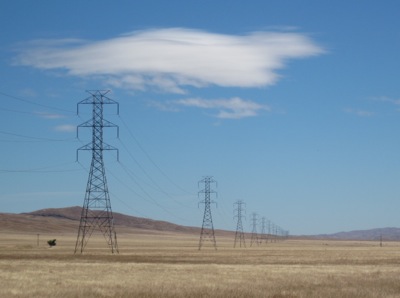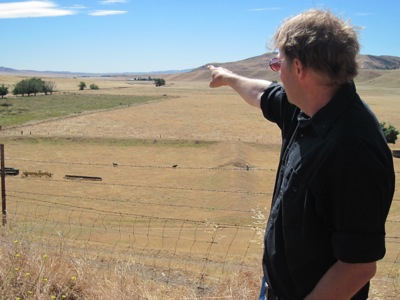The “33 x 20” series continues Monday on Quest Radio, with the first of two parts on the proposed Solargen project in San Benito County. The reports will be repeated on The California Report weekly magazine.
Well hidden among the coast ranges of San Benito County, there’s a valley where, as one ecologist put it, “the hammer is hitting the anvil.” Mike Westphal of the Bureau of Land Management’s Hollister field office was describing the current tension playing out in Panoche Valley between two environmental goals: the mandate to combat global warming with a transition to renewable energy, and the desire to conserve the habitat of endangered animals, as well as California’s remaining ag land.

As part of our collaborative series: “33 x 20: California’s Clean Power Countdown,” Quest Senior Editor Andrea Kissack and I have been exploring the effort by Solargen Energy to develop Panoche Valley as a utility-scale solar power array (the state defines “utility-scale” as any facility that produces 200 megawatts of electricity or more).
Like many developers, Solargen CEO Mike Peterson is racing to break ground by the end of this year, in order to cash in on up-front stimulus money from the federal government. He says Panoche Valley presents a rare alignment of attributes for solar power: high solar potential (he says 90% of the Mojave), relative proximity to population centers, and existing transmission lines to get the power there. Peterson told me that the lines already in place have enough available capacity to handle his 420 megawatts of solar power, though a spokeswoman for PG&E says that question is still under study.
Meanwhile, some farmers and wildlife advocates have opposed the plan, saying big solar “farms” are better placed on “degraded” land. Ron Garthwaite, who runs Claravale organic dairy, says “This is just not the place to put it. There’s other places which have no ag value and which have less of a natural value where they could put it.”

Westphal, whose agency is not directly involved in assessing the project, sees the valley as a rare microcosm for the once unspoiled habitat of the San Joaquin Valley, just over the hill. “What we really need to think hard about is do we want to risk ecosystems to get energy,” he told me, scanning the valley from Shotgun Pass at the north end. “That’s what’s going on here in Panoche Valley is we’re making this equation: how much do we want to risk the continued endangerment or extinction of this ecosystem in order to get more energy? That’s the crux of this conflict here.”
In this video clip, BLM ecologist Michael Westphal gives Craig Miller an overview of the valley, looking south from Shotgun Pass.
Solargen is shelling out for a $1.3 million-dollar environmental impact report, which Peterson says does not include measures such as the two dozen biologists and a detachment of scat-sniffing dogs, trained to track down the droppings of other critters for DNA analysis. The results help determine what species are there. Peterson says the total tab in “preparing and preparing for the EIR” now tops $7 million.
In Part 2 of our Panoche Valley “case study,” Andrea Kissack will have a closer look at the wildlife issues. That report runs next Monday, June 28, on Quest Radio.
As for the Governor’s ambitious goal to have renewable energy sources account for one third of the state’s electrical generation by 2020, Peterson describes the process as “surprisingly harder than you would expect.” He says he ponders how to “get this done in a way that is able to meet the mandates, but also be a good steward to the environment, and try to make people happy. And we won’t be able to please everybody.”
He’s right about that. Dairyman Garthwaite says of the state’s quest for renewables: “Just because somebody in Sacramento says something, doesn’t mean that it can happen–or should happen. I mean there’s all kinds of political things involved in that, there’s lobbyists involved in that. People want to make money.”
Climate Watch intern Chris Penalosa mapped some of California’s larger solar projects in development, below.
View Utility Scale Solar Projects in California in a larger map
6 thoughts on “Clock Ticking for Solar Developers”
Comments are closed.

Peterson’s comment “I thought everyone wanted solar” should have been balanced in the broadcast. Of course we want solar energy, but studying the Solargen’s March, 2010 Annual Rept, the risks stated are irresponsible. We want roof-top solar on existing infrastructure not paving over the life giving benefits of Panoche Valley. P.V. panels on home and businesses will be available to us in fall as San Benito has agreed to the CaliforniaFIRST Pilot Program. Here are
jobs and income as well, in answer to the Super-visor’s statement. Peterson’s comment is “it’s easier in Texas” to put in this power plant — Then why isn’t he there? His project belongs on wasted land, or industrial zoned, not 4,700 acres (panels) plus 11,000 acres (mitigation) in his corporation’s control. This is Class One soil being sustainably, naturally farmed with local produce and products for our region and compatiable with wildlife habitat. This is the right direction for our current needs of wise decisions, not destroying all this for such a
Solargen power plant.
Thanks for your comment. I’m glad you brought this up. I think Garthwaite’s comment helped to balance it, saying in essence that the alternative “value” of that particular land trumps Solargen’s intended use. Unfortunately we didn’t have time to get into the distributed power debate but we will in a future report. There is stark disagreement over whether we can “get the job done” with distributed generation (i.e. rooftop solar) and we will examine that as part of this series.
This is also a good chance to remind listeners that what you’ve heard so far is part one of a two-part series on Panoche Valley. Part 1 was intended to lay out the parameters of the project, explain why it’s attractive to Solargen, and then set up the conflicts for Part 2. Next week, Andrea will devote much more time to outlining the rationale of those objecting to the project. We hope that you’ll find balance in the series as a whole.
roof top solar is not yet feasible in most cases. While we diddle, we delay reducing the need for hydrocarbon based energy. Independent of one’s view on global climate change, we are “spilling” solar energy daily by not capturing it where it does make economic sense.
Thank you Chris & KQED for your great invetigative reporting and keeping the people informed. I keep hearing roof top solar is not yet feasible, but what does this mean really? Feasible for what? Is it worth the loss of habitat to already endangered species and loss of farm and ranch land to create green engery? Then when you look deeper into the Panoche Valley project and see that Solargen is in contract to purchase solar panels made in China, think about the carbon footprint of manufacturing the panels in China and shipping them to the US. This particular project appears to be less green the more you look into the details. Let’s support solar on rooftops, in urban areas and on brownfields and see if we cannot make it feasible! I’m curious to learn more about California’s mandate, what happens if the mandate is not met?
Currently, the “mandate” is contained in an executive order issued by Gov. Schwarzenegger in 2008. A bill is moving through the legislature to make it law, but I think the real consequences of missing that deadline are still a bit unclear. In the case of the intermediate “20 by 2010” deadline, there’s a three year “compliance window.” In other words, the “real” deadline is 2013. Beyond that, utilities would be penalized for non-compliance.
As for rooftop solar, the National Renewable Energy Lab estimates that it could potentially account for 10-25% of “electricity supply.” But on-site “PV” has some important limitations. A 23-page report is available from the Lab in PDF format at:
http://www.nrel.gov/docs/fy09osti/44073.pdf
One of the uses of this land has also been for astronomical teaching and research. The very qualities that make it good for solar also make it good for astronomy – elevation above the San Jaquin and coastal fog, and it’s dark rural landscape. It has been the site of important research studies of meteor showers, and for numerous field study sessions of the Cabrillo College Astronomy Department’s courses. If, like most industrial establishments, this one is lit for safety or security reasons, it’ll ruin the area for astronomy. And, frankly, I love this area just because of it’s naturalness and isolation amid a never-ending encroachment of ranch-style tract housing developments.
The spiritual place for solar is roof-top and city-scape and parking garage locations, not huge industrial developments.